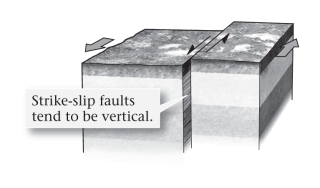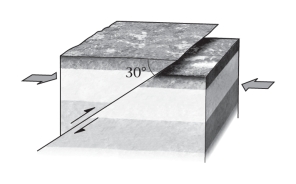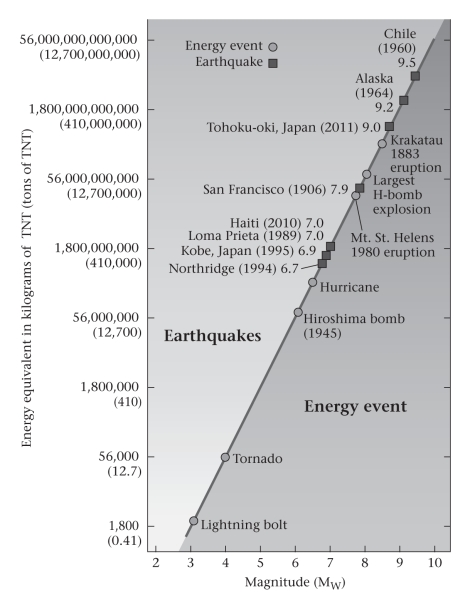A) both S- and P-waves
B) both L- and R-waves
C) both surface and interior waves
D) P-waves only
Correct Answer

verified
Correct Answer
verified
Multiple Choice
If a fault is nearly vertical in orientation and the two walls of rock on opposite sides slide past one another horizontally,the fault is termed ____________.

A) normal
B) reverse
C) strike slip
D) thrust
Correct Answer

verified
Correct Answer
verified
True/False
All discovered faults are likely to experience earthquakes in the next few hundred years.
Correct Answer

verified
Correct Answer
verified
Multiple Choice
Which type of earthquake has the highest velocity?
A) L-wave
B) P-wave
C) R-wave
D) S-wave
Correct Answer

verified
Correct Answer
verified
Multiple Choice
If,during an earthquake,a hanging wall slides upward relative to a footwall,the fault is termed ____________ if the fault is shallow (much closer to horizontal than vertical) .

A) normal
B) reverse
C) strike slip
D) thrust
Correct Answer

verified
Correct Answer
verified
Multiple Choice
Faulting and earthquakes are examples of ____________.
A) brittle behavior
B) ductile behavior
Correct Answer

verified
Correct Answer
verified
Multiple Choice
Which type of fault does NOT,by definition,have a fault trace?
A) normal fault
B) reverse fault
C) blind fault
D) None of the above are correct;all faults have recognizable traces.
Correct Answer

verified
Correct Answer
verified
Multiple Choice
All else being equal,an earthquake that strikes in the eastern United States would produce shaking that would be felt ____________ than one that occurred in the western United States.
A) over a greater distance
B) over a lesser distance
C) over the same distance
Correct Answer

verified
Correct Answer
verified
Multiple Choice
Faults that have moved recently or are likely to move in the future are referred to as ____________.
A) passive
B) active
C) normal
D) reverse
Correct Answer

verified
Correct Answer
verified
Multiple Choice
Generally,which type of earthquake waves travel fastest?
A) interior waves
B) R-waves
C) surface waves
D) body waves
Correct Answer

verified
Correct Answer
verified
Multiple Choice
How many seismic stations are necessary to find the epicenter of an earthquake?
A) one
B) two
C) three
D) four
Correct Answer

verified
Correct Answer
verified
Multiple Choice
What geological setting(s) would you expect to produce seismic activity?
A) Rift valley
B) Basin
C) Collisional mountain belt
D) All of the above are correct.
Correct Answer

verified
Correct Answer
verified
Multiple Choice
Surface waves ____________.
A) travel more rapidly than body waves
B) produce most of the damage to buildings during earthquakes
C) are the first waves initially produced in an earthquake
D) are the first waves to arrive at a seismograph station after an earthquake
Correct Answer

verified
Correct Answer
verified
Multiple Choice
Geologists who specifically study earthquakes are called ____________.
A) seismologists
B) paleontologists
C) vulcanologists
D) speleologists
Correct Answer

verified
Correct Answer
verified
Multiple Choice
At any point along the surface of an oblique (nonvertical) fault,the ____________.

A) hanging wall lies vertically above the footwall
B) footwall lies vertically above the hanging wall
C) hanging wall lies to the left of the footwall
D) footwall lies to the left of the hanging wall
Correct Answer

verified
Correct Answer
verified
True/False
Virtually all of the deaths attributed to major earthquakes have resulted from the collapse of buildings.
Correct Answer

verified
Correct Answer
verified
Multiple Choice
A surface along which rock on opposed sides is offset by earthquake-induced slip is called a ____________.
A) joint
B) fault
C) fold
D) wall
Correct Answer

verified
Correct Answer
verified
Multiple Choice
Which earthquake severity scale takes into account the type of rock that has been fractured?
A) Richter scale
B) Mercalli scale
C) seismic-moment magnitude scale
Correct Answer

verified
Correct Answer
verified
Multiple Choice
The greatest earthquake ever recorded by seismographs occurred in 1960 in Chile and measured ____________ on the seismic-moment magnitude scale.

A) 9.0
B) 9.5
C) 10.0
D) 10.5
Correct Answer

verified
Correct Answer
verified
Multiple Choice
Earthquakes that occur in a band called a ____________ can be used to track the motion of subducted oceanic lithosphere.
A) Wegener belt
B) seismic gap
C) Wadati-Benioff zone
Correct Answer

verified
Correct Answer
verified
Showing 21 - 40 of 50
Related Exams